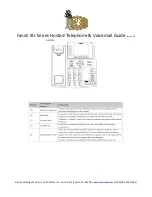
81
Glossary
N
NAT
Network Address Translation
Method for converting (private)
to one or more (public)
IP addresses. NAT enables the IP addresses of
(e.g., VoIP telephones) in a
to be concealed behind a shared IP address
on the
.
VoIP telephones behind a NAT router cannot be reached by VoIP servers
(because of the private IP address). In order to "get around" NAT, it is possible
to use (alternatively)
in the router,
in the VoIP telephone, or for
the VoIP provider to use an
If an outbound proxy is made available you must allow for this in the
VoIP settings for your phone.
Network
Group of devices. Devices can be connected in either wired or wireless
mode.
Networks can also differ in range and structure:
– Range: local networks (
) or wide area networks (
– Structure:
or ad-hoc network
Network subscribers
Devices and PCs that are connected to each other in a network, e.g., servers,
PCs and phones.
O
Outbound proxy
Alternative NAT control mechanism to STUN and ALG.
Outbound proxies are implemented by the VoIP provider in firewall/NAT
environments as an alternative to
. They control data traffic
through the firewall.
Outbound proxy and STUN servers should not be used simultaneously.
See also:
P
PIN
Personal Identification Number
Protects against unauthorized use. When the PIN is activated, a number
combination has to be entered in order to access a protected area.
Port
Data is exchanged between two applications in a
via a port.
Port Forwarding
The Internet gateway (e.g., your router) forwards data packets from the
that are directed to a certain
to the port concerned.
This allows servers in the
to offer services on the Internet without you
needing a public IP address.










































